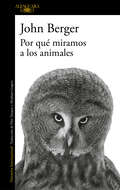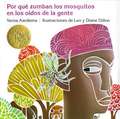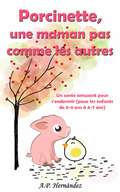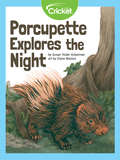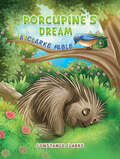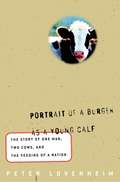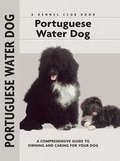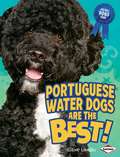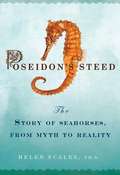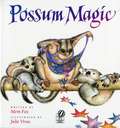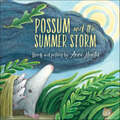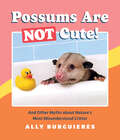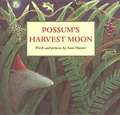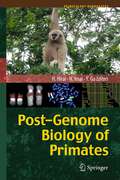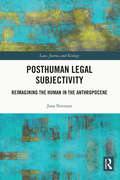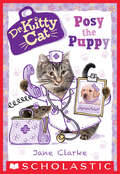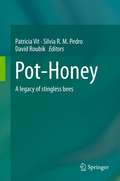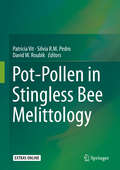- Table View
- List View
Por qué Coyote aúlla a la luna (¡Arriba la Lectura!, Level K #38)
by Rob Arego Vicki BradleyCoyote quiere atrapar a Conejo para comérselo, pero Conejo tiene un plan. ¿Funcionará? Lee la historia para descubrir qué pasó. NIMAC-sourced textbook
Por qué el leopardo tiene manchas (¡Arriba la Lectura!, Level L #51)
by Katherine Mead Barry RockwellEl leopardo no siempre ha tenido manchas. ¿Cómo crees que las consiguió? NIMAC-sourced textbook
Por qué los mosquitos nos zumban en los oídos
by Bill Greenhead Alison Adams Paul LevenoNIMAC-sourced textbook
Por qué migran los animales (¡Arriba la Lectura!, Level N #44)
by Debbie CroftLa migración es importante para muchos animales. Los animales migran buscando una alimentos, áreas más cálidas donde vivir y lugares seguros donde tener sus crías. Descubre cuándo, dónde y por qué migran los animales. NIMAC-sourced textbook
Por qué miramos a los animales
by John BergerNadie como el premio Booker John Berger para enseñarnos a ver y a vernos. «Desde D. H. Lawrence no ha habido un escritor como Berger, capaz de ofrecer al mundo tal atención sobre los problemas humanos más disímiles, con una sensualidad que no renuncia a los imperativos de la conciencia y la responsabilidad».Susan Sontag John Berger revolucionó nuestra manera de ver el arte, la sociedad y la naturaleza, animándonos a mirar el mundo como si se tratara de la primera vez. Este libro es una buena muestra de ello: variando en tono desde la anécdota tierna hasta el ensayo profundo, el ganador del Premio Booker se pregunta cómo y por qué nos hemos vuelto incapaces de ver realmente a los animales, a los que hemos convertido en muñecos, juguetes y personajes de cuentos infantiles. Berger nos ofrece un diagnóstico, pero también una salida: la solidaridad entre oprimidos, la creación de un lenguaje común y una nueva mirada emancipadora tanto para el que mira como para el que es mirado.Alfaguara recoge los ensayos, algunos inéditos en castellano, que Berger dedicó a nuestra relación con los animales y a diversas luchas sociales en un libro que muestra una vez más la sensibilidad y el compromiso del autor en temas de intensa relevancia actual. La crítica ha dicho...«Su obra parece labrada con una precisión de relojero, y una intimidad que podría confundirse con ternura».The New York Times Book Review «Fue el Leonard Cohen de otra clase de rotunda melancolía: la de la tristeza (social, íntima) que provoca el auténtico saber en mitad de la sociedad capitalista de fauces abiertas y hambre incansable».Diego Medrano, El Comercio«Berger es el fecundo, sugerente e irónico escritor de las verdades».Manuel Rivas «Una de las voces esenciales para comprender el estado de nuestra sociedad [...]. Combina a la perfección compromiso y reflexión».El Confidencial «Sus contemporáneos más cercanos en términos de audacia estética podrían ser Umberto Eco o el tardío W. G. Sebald, pero resulta difícil compararlo a cualquier autor inglés del último medio siglo. Berger, simplemente, rompió todos los moldes».The Guardian «Fue la voz de los frágiles, residuos del mundo moderno a los que su obra otorgó dignidad de reyes [...]. Poeta, novelista, ensayista y crítico de arte, toda su obra literaria es el testimonio de alguien que contempla un universo que se desvanece ante sus ojos».Javier Rodríguez Marcos, El País «Un faro de luz tenue pero inagotable, constante, esperanzada».Àlex Susana, Ara «Los libros de Berger poseen la peculiar cualidad de parecer libros solo por azar. Hechos de palabras, las portan, sin embargo, con indulgencia, casia regañadientes, como si igual pudieran estar hechos de lienzo y pintura o, aún mejor, de polvo y paja, barro y hueso».Herald Tribune
Por qué zumban los mosquitos en los oídos de la gente (Ediciones Dial)
by Verna Aardema Leo Dillon Diane Dillon Osvaldo BlancoA mosquito annoyed the iguana, who frightened the python, who scared the rabbit'and now the whole jungle is in an uproar because the sun won't rise. The animals discuss the situation and decide to punish the mosquito. Even today whenever we hear a mosquito buzz, we smack it hard! Leo and Diane Dillon won the 1976 Caldecott Medal for Why Mosquitoes Buzz in People's Ears, making Leo Dillon the first African-American artist to be so honored. Now this classic, which has delighted millions of children, is at last available in Spanish.
Porcinette, une maman pas comme les autres: Un conte amusant pour s'endormir (pour les enfants de 3-4 ans à 6-7 ans)
by A. P. HernándezEn se réveillant, Porcinette découvre un oeuf. Celui-ci, qu'on dirait sorti de nulle part, constitue un véritable mystère. A qui appartient-il ? Comment est-il arrivé jusque là ? Est-ce que quelqu'un le cherche ? Porcinette, dont le plus grand souhait est de devenir mère, souhaite le garder et le couver avec tendresse et grand soin, mais Jean, son ami l'âne, la convainc d'abord de trouver sa mère. C'est ainsi que Porcinette et son fidèle conseiller Jean entreprennent de faire le tour de la ferme afin de percer le mystère qui plane autour de cet oeuf. Ce compte a été conçu pour aborder, sous forme ludique et didactique, des valeurs comme la responsabilité, l'engagement, l'honnêteté, la générosité et l'amour. Un ingénieux livre pour enfant que les parents, les enseignants de maternelle et d'élémentaire, les pédagogues et les psychologques peuvent utiliser pour transmettre des valeurs.
Porcupette Explores the Night
by Susan Yoder AckermanDid you know a baby porcupine is called a porcupette? Learn about porcupines as you follow Porcupette through the forest one night as she looks for a snack!
Porcupine's Dream: A Clarke Fable
by Constance ClarkeIn this imaginative Clarke Fable, your child will learn the lesson of self-acceptance.The sleepy little porcupine finds that what makes her unique, makes her wonderfully special.Be sure to watch for the bluebird who hides in and out of the story&’s colorful pages!
Porcupines (Nature's Children)
by Laima DingwallWhen do porcupines sing? What's a porcupette? Why do porcupines eat sneakers and steering wheels? Find the answers to these questions, and learn much more about the physical characteristics, behavior, habitat, and lives of porcupines. Other books in this series are available in this library.
Portrait of a Burger as a Young Calf: The Story of One Man, Two Cows, and the Feeding of a Nation
by Peter LovenheimFour years ago, journalist Peter Lovenheim was standing in a long line at McDonald's to buy a Happy Meal for his little daughter, which would come with a much-desired Teenie Beanie Baby--either a black-and-white cow named "Daisy" or an adorable red bull named "Snort. " Finding it rather strange that young children were being offered cuddly toy cows one minute and eating the grilled remains of real ones the next, Lovenheim suddenly saw clearly the great disconnect between what we eat and our knowledge of where it comes from. Determined to understand the process by which living animals become food, Lovenheim did the only thing he could think of: He bought a calf--make that twin calves, number 7 and number 8--from the dairy farm where they were born and asked for permission to spend as much time as necessary hanging around and observing everything that happened in the lives of these farm animals. Portrait of a Burger as a Young Calf is the provocative true story of Peter Lovenheim's hands-on journey into the dairy and beef industries as he follows his calves from conception to possible consumption. In the process, he gets to know the good, hard-working people who raise our cattle and make milk products, beef, and veal available to consumers like you and me. He supplies us with a "fly on the wall" view of how these animals are used to put food on America's very abundant tables. Constantly vigilant about wanting to be an observer who never interferes, Lovenheim allows the reader to see every aspect of a cow's life, without passing judgment. Reading this book will forever change the way you think about food and the people and animals who provide it for us.
Portrait of a Burger as a Young Calf: The True Story of One Man, Two Cows, and the Feeding of a Nation
by Peter LovenheimWhen Lovenheim's young daughter asks where hamburger comes from, he sets out to find a detailed answer to her question. He visits farms in New York state and buys two beef calves to follow through the beef production process. He presents a lot of information in a way which is clear and readable. He treats the farmers' actions and decision with respect and compassion even when he is dealing with the hard lives of the animals and their keepers. The author shares his own struggles concerning the slaughter of animals especially his own two cows. He interviews folks who revere cows and those who relish their best steaks. Excellent descriptions. Possibly a bleak subject, but definitely a captivating book.
Portuguese Water Dog (Comprehensive Owner's Guide)
by Carol Ann Johnson Paolo Correa Karen TaylorThe experts at Kennel Club Books present the world's largest series of breed-specific canine care books. Each critically acclaimed Comprehensive Owner's Guide covers everything from breed standards to behavior, from training to health and nutrition.
Portuguese Water Dogs Are the Best! (The Best Dogs Ever)
by Elaine LandauWhat's that dog with the fluffy fur, playful personality, and great love of swimming? It's the Portuguese water dog! Portuguese water dogs have boundless energy, and they're loyal and loving too. Their owners think they are the best dogs ever--and it's easy to see why. If you're a Portuguese water dog fan, you'll want to learn all about this breed, from its keen smarts and good-looking coat to its history as a fishing dog in Portugal. You'll also want to find out how to care for the Portuguese water dog. So check out this go-to guide for Portuguese water dog lovers--and learn all about why Portuguese water dogs are the best breed there is!
Poseidon's Steed
by Helen ScalesA fascinating journey with the sea creature that has captured human imagination for thousands of years Poseidon's Steed trails the seahorse through secluded waters across the globe in a kaleidoscopic history that mirrors man's centuries-old fascination with the animal, sweeping from the reefs of Indonesia, through the back streets of Hong Kong, and back in time to ancient Greece and Rome. Over time, seahorses have surfaced in some unlikely places. We see them immortalized in the decorative arts; in tribal folklore, literature, and ancient myth; and even on the pages of the earliest medical texts, prescribed to treat everything from skin complaints to baldness to flagging libido. Marine biologist Helen Scales eloquently shows that seahorses are indeed fish, though scientists have long puzzled over their exotic anatomy, and their very strange sex lives -- male seahorses are the only males in the animal world that experience childbirth! Our first seahorse imaginings appeared six thousand years ago on cave walls in Australia. The ancient Greeks called the seahorse hippocampus (half-horse, half-fish) and sent it galloping through the oceans of mythology, pulling the sea god Poseidon's golden chariot. The seahorse has even been the center of a modern-day international art scandal: A two-thousand-year-old winged seahorse brooch was plundered by Turkish tomb raiders and sold to the Metropolitan Museum of Art in New York. A book that is as charming as the seahorse itself, Poseidon's Steed brings to life an aquatic treasure. Seahorses lead quiet lives, tucked away out of sight on the seafloor. It is rare to catch a glimpse of a seahorse in its natural habitat. But even if few have seen one live, these exotic, seemingly prehistoric creatures exist quite vividly in our imaginations and they have mesmerized scientists, artists, and storytellers throughout time with their otherworldly rarity. Poseidon's Steed is a sweeping journey that takes us from the coral reefs and seagrass meadows of Indonesia where many seahorses makes their natural habitat to the back streets of Hong Kong where a thriving black market seahorse trade is concealed. Throughout history, seahorses have surfaced in some unexpected places and Scales also follows the seahorse back in time, from our most rudimentary seahorse imaginings six thousand years ago on cave walls in Australia, to the myths of ancient Greece. Scientists have long puzzled over seahorses' unusual anatomy and their very strange sex lives. And male seahorses are the only males in the animal world that experience childbirth! Seahorses are not what scientists call a "keystone" species. They rely on a healthy ocean to survive, but the marine ecosystem does not rely on them. But their delicate beauty reminds us that we rely on the seas not only to fill our dinner plates, but also to feed our imaginations.
Possum Magic
by Mem FoxGrandma Poss uses her best bush magic to make Hush invisible. But when Hush longs to be able to see herself again, the two possums must make their way across Australia to find the magic food that will make Hush visible once more. Another treat from Mem Fox that is sure to be treasured. The whimsical illustrations are a wonderful complement.--Childrens Book Review Service
Possum and the Summer Storm
by Anne HunterPossum returns in a lushly illustrated story about new homes and old friends—perfect for fans of Possum's Harvest Moon, Kevin Henkes, and Beth Krommes. Possum looked out one summer afternoon. &“Time to come in!&” he called to his baby possums. &“It looks like we&’re in for some weather!&” Possum calls his children out of the summer storm—but what can he do when their home is swept away by rising water? The possum family must rely on their friends to construct a new house. At first it seems that no other animal's home is suited for a possum, but they come up with something spectacular! Beloved character Possum is back, along with an array of friends who make for a broad, ranging ensemble, giving children a tantalizing peek at how different animals build their homes.
Possum's Bare Tail (Houghton Mifflin Reading Leveled Readers)
by Jiang Qingling"In this story, the animals act like people. After reading the story think about what you have read: 1 What is Possum like at the beginning of the folktail? 2 What is Rabbit's plan to cure Possum of his pride? 3 What do you think of Rabbit's plan? 4 How does one of Possum's special talents help him at the end of the folktale?"
Possums Are Not Cute!: And Other Myths about Nature's Most Misunderstood Critter
by Ally BurguieresPossums may steal your garbage…but with this book, they&’ll also steal your heart!Possums are more than the ugly-cute icons of the internet. These so-called trash animals and pointy kitties are not only relatable avatars for anxious but resilient people everywhere, but nature&’s secret clean-up crew. Organized around common myths that have given possums a bad reputation, this fun and offbeat book reveals the truth about possums through dozens of adorable photos, informative illustrations, and fascinating facts. Did you know that… • Possums protect people and pets from disease! A single possum can eat up to 4,000 ticks per week! • Possums excel at interspecies friendships, often sleeping in other animals&’ dens. • Possums are shy creatures: when they &“play dead,&” they are actually fainting from anxiety! Written by wildlife rehabber and possum advocate Ally Burguieres, known for her popular Instagram account @ItsMeSesame, this accessible and giftable guide explains why possums deserve our admiration and offers tips on how we can protect and advocate for these magical marsupials.
Possums Harvest Moon
by Anne HunterWhen Possum sees the biggest, brightest, yellowest moon shining down one autumn night, he decorates the grass with lanterns and berries and heads out to invite the mice, the crickets, Racoon, Rabbit and other friends to his "Harvest Soiree".
Post-Genome Biology of Primates
by Hiroo Imai Yasuhiro Go Hirohisa HiraiIn 2001, first reports of the human draft genome were published. Since then, genomes of many other organisms have been sequenced, including several primate species: the chimpanzee, rhesus macaque, gorilla, orangutan, gibbon, baboon, marmoset, tarsier, galago, lemur, and more recently Neanderthals. In a new era of "post-genome biology", scientists now have the vast amount of information revealed by genome research to confront one of the most challenging, fundamental questions in primatology and anthropology: What makes us human? This volume comprises a collection of articles on a variety of topics relevant to primate genomes, including evolution, human origins, genome structure, chromosome genomics, and bioinformatics. The book covers the cutting-edge research in molecular primatology and provides great insights into the functional diversity of primates. This valuable collection will benefit researchers and students, including primatologists, anthropologists, molecular biologists, evolutionary biologists, and animal behaviorists.
Posthuman Legal Subjectivity: Reimagining the Human in the Anthropocene (Law, Justice and Ecology)
by Jana NormanThis book provides a reimagining of how Western law and legal theory structures the human–earth relationship. As a complement to contemporary efforts to establish rights of nature and non-human legal personhood, this book focuses on the other subject in the human–earth relationship: the human. Critical ecological feminism exposes the dualistic nature of the ideal human legal subject as a key driver in the dynamic of instrumentalism that characterises the human–earth relationship in Western culture. This book draws on conceptual fields associated with the new sciences, including new materialism, posthuman critical theory and Big History, to demonstrate that the naturalised hierarchy of humans over nature in the Western social imaginary is anything but natural. It then sets about constructing a counternarrative. The proposed ‘Cosmic Person’ as alternative, non-dualised human legal subject forges a pathway for transforming the Western cultural understanding of the human–earth relationship from mastery and control to ideal co-habitation. Finally, the book details a case study, highlighting the practical application of the proposed reconceptualisation of the human legal subject to contemporary environmental issues. This original and important analysis of the legal status of the human in the Anthropocene will be of great interest to those working in legal theory, jurisprudence, environmental law and the environmental humanities; as well as those with relevant interests in gender studies, cultural studies, feminist theory, critical theory and philosophy.
Posy the Puppy (Dr. KittyCat #1)
by Jane Clarke“Beatrix Potter meets Grey’s Anatomy as a feline medic tends to animals’ scraped ears, hurt ankles, and other bumps and bruises in this series opener.” —Publishers WeeklyWe’ll be there in a whisker! Dr. KittyCat is a talented vet—and an adorable cat. She’s ready to rescue whenever help is needed.When a call comes in that Posy the puppy has hurt her leg at the Paws and Prizes field day, Dr. KittyCat rushes to the scene. Without Dr. KittyCat’s help, Posy will be disqualified!Posy has two-color art inside! Supercute photographs of real animals combine with hand-drawn purple line art for a completely unique look.“Cuddly animals everywhere are lucky to have Dr. KittyCat on call.” —Kirkus Reviews
Pot-Honey: A Legacy of Stingless Bees
by Patricia Vit David Roubik Silvia R. PedroThe stingless bees are one of the most diverse, attractive, fascinating, conspicuous and useful of all the insect groups of the tropical world. This is a formidable and contentious claim but I believe it can be backed up. They are fifty times more species rich than the honey bees, the other tribe of highly eusocial bees. They are ubiquitous in the tropics and thrive in tropical cities. In rural areas, they nest in a diversity of sites and are found on the flowers of a broad diversity of crop plants. Their role in natural systems is barely studied but they almost certainly deserve that hallowed title of keystone species. They are popular with the general public and are greatly appreciated in zoos and gardens. The chapters of this book provide abundant further evidence of the ecological and economic importance of stingless bees.
Pot-Pollen in Stingless Bee Melittology
by Patricia Vit Silvia R.M. Pedro David W. RoubikThis book covers pot-pollen—the other product, besides honey, stored in cerumen pots by Meliponini. Critical assessment is given of stingless bee and pot-pollen biodiversity in the Americas, Africa, Asia and Oceania. Topics addressed include historical biogeography, cultural knowledge, bee foraging behavior, pollination, ecological interactions, health applications, microbiology, the natural history of bee nests, and chemical, bioactive and individual plant components in stored pollen. Pot-pollen maintains the livelihoods of stingless bees and provides many interesting biological products that are just now beginning to be understood. The Meliponini have developed particular nesting biologies, uses of building materials, and an architecture for pollen storage. Environmental windows provide optimal temperature and availability of pollen sources for success in plant pollination and pollen storage. Palynological composition and pollen taxonomy are used to assess stingless honey bee pollination services. Pollen processing with microorganisms in the nest modifies chemical composition and bioactivity, and confers nutraceutical benefits to the honey and pollen widely relished by native people. Humans have always used stingless bees. Yet, sustainable meliponiculture (stingless bee-keeping) projects have so far lacked a treatise on pot-pollen, which experts provide in this transdisciplinary, groundbreaking volume.

